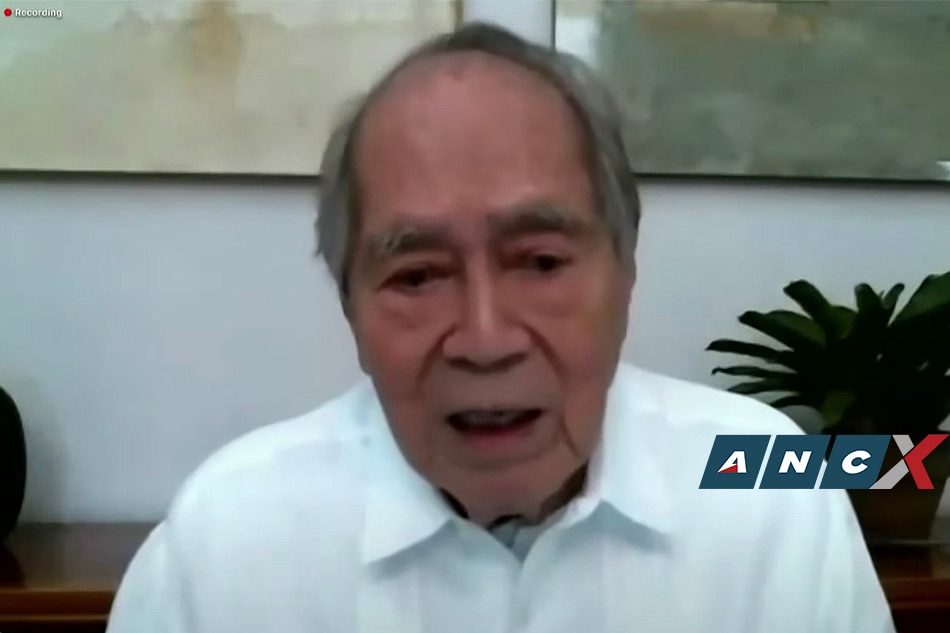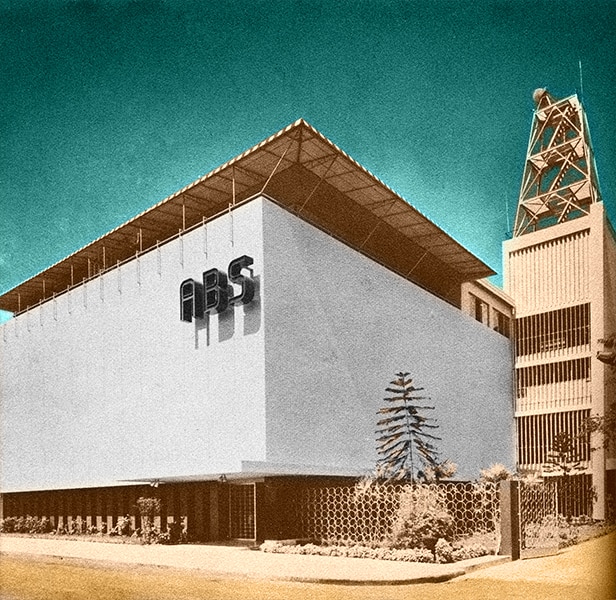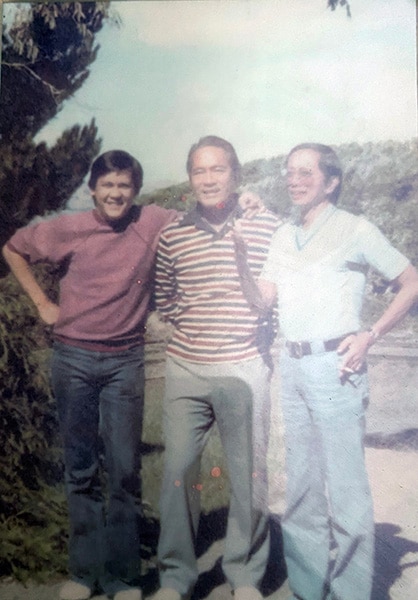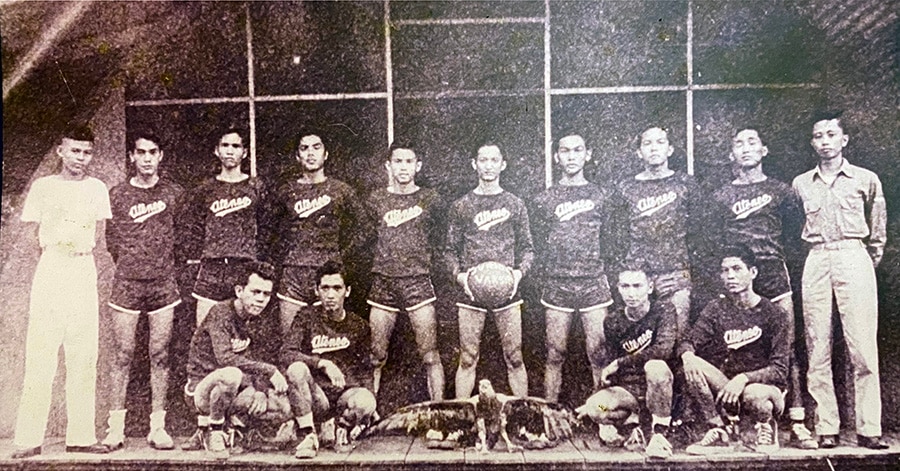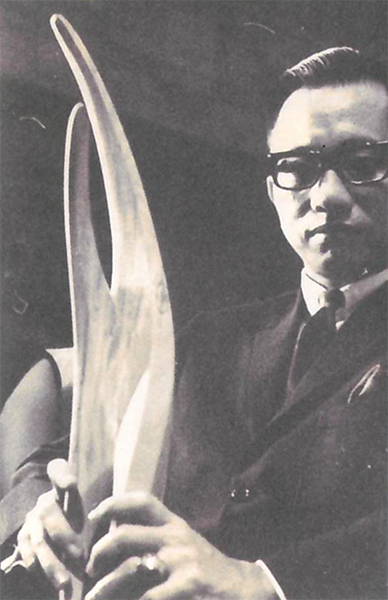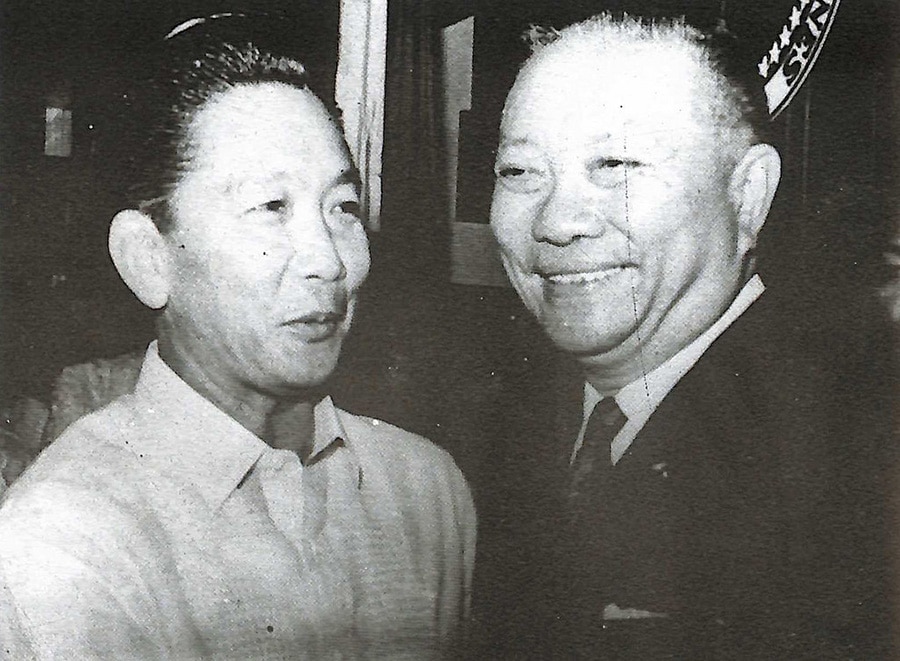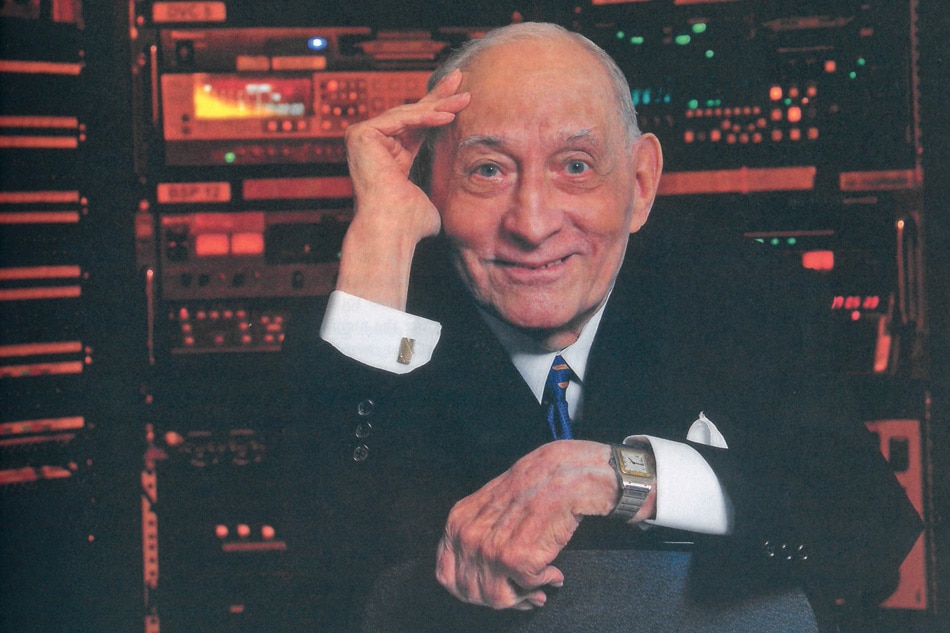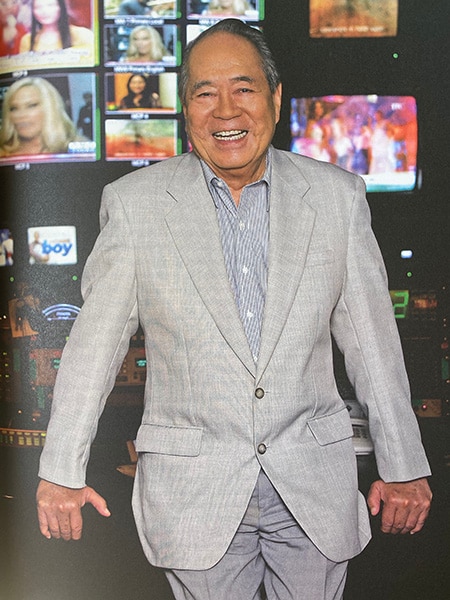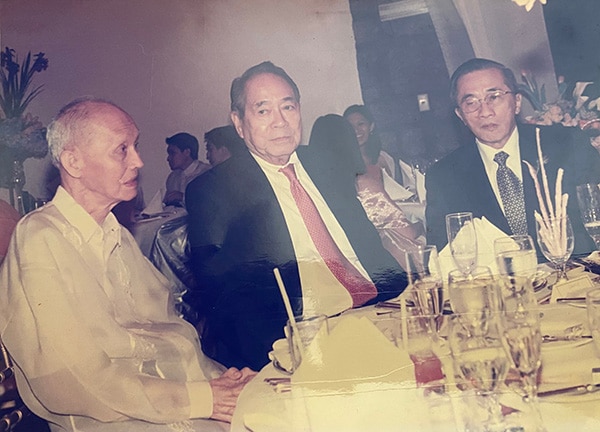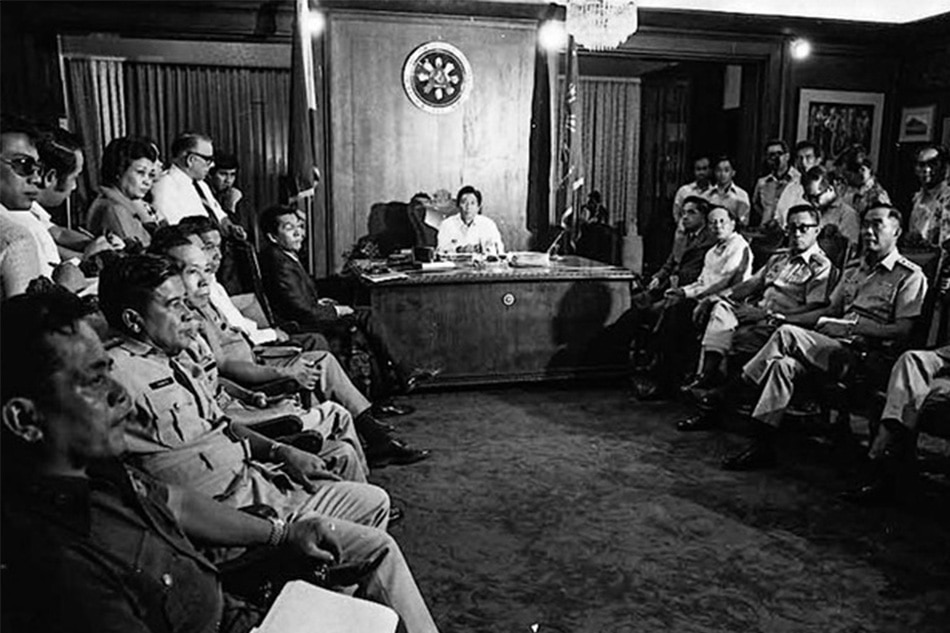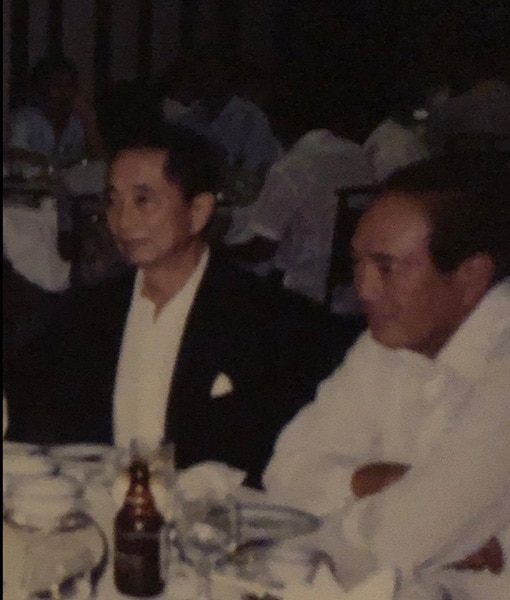Last June 17 at the congressional hearings for the renewal of the ABS-CBN franchise, ABS-CBN vice chairman Atty. Augusto “Jake” Almeda-Lopez appealed to Congress to recognize the value and the major contributions of ABS-CBN and its 11,000 workers to the country.
“Can you give me another two minutes? You know we are fighting for our lives,” Almeda-Lopez asked the congressmen.
Jake has been at the forefront of the many battles that ABS-CBN has had to face in its almost 75-year history. At the age of 91, he’s still fighting for the network he helped build, this time facing impatient lawmakers tackling the franchise renewal while ABS-CBN remains shut for a month and a half now. Jake turns 92 on June 28, the day his best friend—and if it can be said, his true soul mate—Eugenio “Geny” Lopez Jr., passed away. Kapitan, as his employees called Geny, succumbed to prostate cancer in 1999.
“We deserve the renewal of our franchise,” Atty Jake said in his appeal, “and that if you don’t renew our franchise you’re going to deprive the public of so much entertainment, news, and more or less the building of culture. So I plead to the members of Congress to give ABS-CBN a chance to show its worth and contribution to the country.”
The story of Attorney Jake Almeda Lopez is closely intertwined with ABS- CBN’s own story of triumphs and travails.
Geny would always say about his friend and colleague, “Jake is the soul of ABS-CBN—no question about it."
The following is an excerpt from the book Kapitan, published in 2006 and authored by Raul Rodrigo which underscores Atty Jake Almeda-Lopez’ crucial role in the shaping of ABS-CBN.
——-
AS 1965 ENDED, GENY LOPEZ felt elated by ABS-CBN’s recent triumphs in TV—yet, he was still dissatisfied. Geny was the type to move the goal posts for himself. Now he reset his sights on his old dream: a truly national network, unquestionably dominant in both TV and radio. In the distance, he foresaw an ABS-CBN that would help bring together the nation, like a string joining many pearls—a vision he would later call “Bridges on the Air.”
To build it, Geny first had to achieve many pressing tasks: first of all, overtaking MBC once and for all in radio. Second, Geny had to build much more infrastructure. During 1962-66, he had waged a war for TV domination on the cheap—with tight budgets and virtually no bank financing. Geny had to invest much more to make his hardware match his dreams.
Geny had other tasks to undertake, comparatively smaller tasks, but nonetheless important. He had to create a solid corporate identity for his network, which in 1966 was still not even named "ABS-CBN." It was called that only in ads, but the network was still formally and legally Bolinao Electronics Corporation—neither easily pronounceable nor easily marketable. He had to put a distinctive stamp on the ABS viewing experience.
In 1966-68 Geny finally put the pieces together.
Brother in arms
As his partner in that undertaking, Geny tapped Augusto Almeda Lopez, better known as “Jake.” They had been good friends since their days in the Ateneo de Manila, 1946-47, where they had formed a rowdy five-man group known by the risqué tag of REGLA (from the initials of Clarito Recto, Virgil Enriquez, Dodo Gonzalez, Geny Lopez and Jake Almeda Lopez). From the Ateneo, Geny went to VMI and Harvard; Jake went to the UP College of Law, and on to place fourth in the 1952 bar exams (with a rating of 93.01%) and make a thriving practice. Geny made him an offer in 1961.
"Why don't we see if we can get you on retainer as one of our lawyers?" he asked Jake. And so Jake began handling cases for ABS, handling personnel and labor problems. Then, soon enough, Geny popped the next question: "Why don't you consider joining us?" More and more responsibility for Jake followed. He headed the ABS personnel division, then worked on provincial operations, and, finally, in 1966, became general manager.
Jake brought to the job his legal training, painstaking attention to detail (Geny called him "a worrier who likes to plan for every eventuality”), and excellent people skills. It was his idea of a great adventure. He said: “Those were really great times. It was always a day-to-day competition. It's a business where you cannot go to sleep and rest on your laurels. The other side would just welcome your going to sleep.
The self-effacing Jake played a pivotal role in the success of ABS-CBN. ABS-CBN veterans like to say: “Geny [Lopez] is the brains of ABS-CBN, but Jake is the soul.” And Geny himself agreed: “Jake is the soul—no question about it.”
Jake and Geny Lopez formed an ideal team. Geny said: “Jake's got a good heart, a lot of malasakit and so people trust him. He is par excellence when it comes to interpersonal relationships. I learned to lean on him, to trust him completely. I learned so much about people from him, about the importance of treating employees well—listening to them, dealing with them, giving them what they truly deserve. [In the early days of ABS-CBN] I was all efficiency and profit-oriented. Jake would balance me beautifully. He would come to me and convince me in his own quiet way that the employees deserved this, or merited this and he always got his way. I am very grateful for that because looking back now, if a lot of our employees remained loyal to us, it was mainly because of him.”
Geny added: “Jake taught me his values. He taught me loyalty, he taught me the importance of malasakit. He taught me the importance of fairness. He taught me the importance of being objective. I learned a lot from him. I’m proud to be his friend."
A good friend of both Geny and Jake was Lorenzo Tañada Jr. (better known as "Tito" or "Tits"), who joined ABS in 1962 and became head of personnel, succeeding Jake; then concurrently head of credit and collection, and legal; and eventually AVP for administration. He had a ringside seat to the partnership. Tits said: "Of course, Jake's promotion to GM meant that executives to whom he used to report were now reporting to him. People who had been with the organization longer were now junior to him. But in the organization, there was never any problem with that, because of who Jake was. He was just so kind and fair that people never had any problem with him. He and Geny really had a beautiful partnership, a really good combination."
Tits recalled that Jake went out of his way to help ABS-CBN people. For example, the network had a "vale" policy, where someone could get an advance before payday. But some executives who had already gotten an advance would ask for additional money. Tits would say, "No," because that was the policy. But they would go to Jake. And then Tits would get a call from Jake, asking him to come over. Tits knew already that when he opened the door to Jake's office, sitting there would be the fellow whose request for an additional vale he denied. Jake would say: "Tits, pagbigyan na natin ito.' Jake would use his name or "Tits" or that of another executive, Nanding Pallarco, who never got vales, just so that the man in need could get another advance.
The Marcos-Lopez partnership
One of Jake’s first and greatest tasks as GM was to plan and fund the expansion of ABS-CBN. A new era had begun and suddenly ABS-CBN could get bank financing.
Jake Lopez had joined the company in 1962, just as the feud with President Macapagal blew open. One of his first assignments as legal counsel was to aid former senator Vicente Francisco, Claudio Teehankee, and Jovito Salonga in the legal defense of the Lopez Group. He recalled: “Macapagal went after us. We could not expand during the period of Macapagal. In fact, we had a difficult time warding off the efforts of these people to close us down.”
In 1964, Don Eugenio decided to go all-out to support Ferdinand Marcos for president to combat the Liberal Party's Macapagal. Fernando Lopez became his running mate. Former CBN executive Simoun Almario was in charge of making TV and radio spots for the Marcos-Lopez campaign. Jun Jison developed a 60-second TV spot for Fernando Lopez. (The Lopez spot took 24 hours to edit—or over two hours per second.) After a heated and lengthy campaign, on November 9, 1965, Marcos and Nanding Lopez defeated Macapagal and his running mate Gerry Roxas at the polls. In the short term, the decision to go with Marcos was a stunning success: the Marcos-Lopez tandem would win two national elections by large margins. The Lopez business empire would grow to extraordinary heights. But supporting Marcos would prove very costly in the long run.
Jake Lopez said: "By then, the 1965 elections were over and Macapagal was gone. So we had a more friendly administration. We came from a very antagonistic situation [with government] and we were hardly making money. But the American banks, because of their experience in the States, knew that broadcasting would grow, that it was a sunrise industry. So they lent us money.
In 1965, ABS-CBN finally turned the corner. It made a profit of P1.037 million, on an income of P8.4 million. ABS-CBN was left with substantial cash in the till even after servicing its debt and issuing dividends. Since the network’s net income grew five times between 1961 and 1969, the US banks found lending to ABS-CBN a good proposition.
Jake’s search for financing was aided by two big US banks, Citibank and Crocker National Bank, which already had a relationship with the Lopez Group. In 1961, Citibank and Crocker were major players in the US bank syndicate that arranged the $66-million letter of credit that enabled Don Eugenio Lopez and his associates to buy Meralco. Now that the political uncertainty about ABS-CBN had lifted, the two banks were eager to get more involved in the Lopez businesses.
As Geny and Jake surveyed the situation at the beginning of 1966, they saw that the scale of the financing available gave them a chance to build an ABS-CBN much bigger than seemed possible only three or four years earlier. They could plan an expansion that would triple their assets in three years. By 1968, a company that in 1966 had only P14.1 million in assets and P108,000 in debt would have assets of P43.2 million and a total debt of P10.6 million. The hungry years were over.
As Tits Tañda said: "Money was very tight in the early 1960s; if I collected P350,000 in a month, Geny would be very happy. In contrast, by the time martial law was declared, we were already collecting by the millions every month."
Making it official
During 1956-66, ABS-CBN was not quite "ABS-CBN" yet. Making it a unified network was not just a legal issue for Geny; it was also a matter of creating a single mindset for all the employees. But the legal identity of the network was a simpler matter for him to settle. Jake Lopez and Tits Tañada worked out the details, and on February 1, 1967, Bolinao Electronics was renamed ABS-CBN Broadcasting Corporation. ABS-CBN became the umbrella for all the franchises, frequencies and people.
At the same time Geny was closing the deal for color TV, he was already neck-deep in planning ABS-CBN's new home. He wanted a new Broadcast Center that was going to be 20 times bigger than what he already had in terms of floor area and facilities.
Since October 1959, Slim Chaney had been championing a move to a 44,027-sq. m. lot along Bohol Avenue that Don Eugenio Lopez had bought (at just P14 per sq. m.) in 1957. Slim concluded that Bohol Avenue would make an ideal new transmitter site. The site sat on an adobe foundation and that was better protected against earthquakes than the Roxas or Aduana sites. It was also less likely to be subject to floods (which was a problem at the TV studios, being right next to Manila Bay). The site was much higher than a sea-level transmitter in Manila and the additional height meant ABS-CBN could send a signal much farther. The lot was big enough to house all the network's different units, with plenty of room for expansion. This plan, however, was shelved in the early 1960s for lack of funds.
But the lot was left idle. Slim’s broadcasting equipment fabrication shop, known as Republic Electronics (REF), and a relatively small transmitter tower around 200 ft. high was transferred to the site in 1962. In early 1966, Geny decided to go ahead with transferring all of ABS-CBN to Bohol Avenue, and he told Jake and Slim to begin planning a Broadcast Center. Geny’s main problem was that imported television equipment was expensive, compounded by the very high customs duties imposed on it. The tax ranged from 25-100%. All told, the equipment would cost around P20 million—very steep, even with financing from US banks. When Geny and Jake added the additional costs of design, construction and other materials, the cost of the Broadcast Center seemed to float way out of reach.
Geny explored having the Customs Code amended—the Lopezes were influential with Congress and Fernando Lopez was vice-president. But Rep. Jose Aldeguer, a close political associate of the Lopezes, advised Geny and Jake that it would be politically unwise for Congress to revise the code to favor ABS-CBN. Aldeguer said to Jake: "Unfortunately, the vice-president is them. You'll just be opening yourselves to criticism. So it would be better to just hold back." So Geny put his expansion plans on hold again.
But the plan for the Broadcast Center was rescued only a few months later by an unlikely player: Jim Lindenberg. Jim had been out of ABS for six years, but he and Geny stayed friendly. After leaving ABS, Jim had remained involved with the broadcasting industry through a small chain of radio stations called Radio Philippines Network (RPN) and a telecom firm called Capitol Wireless. Jim pointed Geny and Jake to a loophole. Radio Communications of the Philippines Inc. (RCPI), a small telecom firm, had a congressional franchise through RA 2036 and RA 4054, which allowed it to import equipment tax free. ABS-CBN's own franchises stated that in the event that another network or broadcasting entity was given better terms and conditions, then these terms and conditions become automatically incorporated in the franchises of ABS-CBN.
Acting on Jim's tip, Jake filed for a so-called ipso facto ruling with the Department of Finance, applying for the same duty-free privileges granted RCPI. In August 1966, the approval for the ABS-CBN application came, signed by Finance Undersecretary Juan Ponce Enrile. The way to building the Broadcast Center was clear.
It was Jake and Cady Carandang who were carrying the ball. Cady became VP for engineering in Slim's place. ABS-CBN engaged John Leitch, a retired CBS VP, as its consultant for engineering for the Broadcast Center. Leitch stayed for six months and made many suggestions to improve operations. No detail, even the design of the doors for the studios, was too small for his review and revision. Another American consultant for the Broadcast Center was Allen Oppergard, tapped for his expertise in TV production.
Geny gave Jake and Cady a simple instruction: build the most advanced broadcast center in Asia rivaling even NHK in Tokyo, and topping anything available in Southeast Asia and Australia. In the planning, Jake and Cady made room for expansion; they did not want the Bohol Avenue studios to suffer the fate of the ABS studios on Roxas Boulevard, which became cramped and inadequate after only four years. Jake and Cady envisioned a large radio-TV theater (what is now Studio 1); four large 60-ft. by 80-ft. studios; two medium size 40-ft by 60 ft. studios; a 40-ft by 60-ft. hall for recording sound tracks; complete lighting facilities with motorized and push button controls; color TV production capability in all the studios; 16 television cameras; a 650-ft transmitter tower, the tallest in the Philippines, and color movie facilities. All of this was to spread over a floor area of 23,078 square meters. The surrounding grounds were to be landscaped into attractive gardens that would provide ready locations for shooting outdoors.
To pay for all this, Geny and Jake arranged for a loan of P10 million from Citibank, carrying interest of 8% a year and secured by all the property and equipment of the company. With the funds and the engineering design in hand, construction of the Broadcast Center began on February 24, 1967.
Geny was determined that the new ABS-CBN studios would be pioneering not just in terms of its engineering. As befit the Lopez family, he wanted it to be a landmark of elegance and style, in the same way that the Meralco building, inaugurated in March 1968, became an emblem of refinement.
He insisted that all the elements make up one harmonious whole, and that the bustling office building should not only be efficient and practical but, with its interior architecture and accessories, also present an integrated art form. The new building hung paintings by Philippine masters on the walls, such as Manansala, HR Ocampo, Jose Joya, and Malang. Even the furniture was modernist and sleek, with a look that would have looked at home in a Fortune 500 office building in New York.
Jake Almeda Lopez said: “If you put up a new house or a new building, you cannot put in your old furniture. With a brand-new building, how can you put an old typewriter there? Our typewriters had to be changed. Our desks too. And that's what I call atmospheric costs. Even the curtains, the plates had the logo."
As part of the drive to create "an integrated work of art," Wili redesigned the logo and made it subtly ubiquitous on the most ordinary items, as if to put stamp on the entire "ABS-CBN experience!” Boo Chanco, then a young reporter, said: "That logo was in the curtain, the plates; in the bathroom, it was on the tiles. It was a sort of indoctrination, really. So the feeling of you being part of ABS-CBN was really there. Wherever you were, you really felt it all over the place. You ate, you slept, you thought ABS-CBN all the way.”
Jake said: "When we moved to Bohol, we were not used to living in such luxurious surroundings. We came from ABS in Roxas; there the offices were clogged with files, with tapes, with what-not. It was a messy place. It was so small and we had so many things. Now [in Bohol] we had to dress up."
On December 18, 1968, the new ABS-CBN Broadcast Center in Bohol Avenue was inaugurated in a TV spectacular. All the network's biggest stars took part in the variety show that followed: Nida Blanca, Pugo, Dolphy, Panchito, Patsy, Sylvia La Torre, Eddie San Jose, Jeanne Young. Diomedes Maturan and Carina Afable did a number to honor "Chelsea Dancetime," the show from the old Republic Supermarket studios where they had gotten their big break. Even Eddie Ilarde and Leila Benitez came to honor "Student Canteen" and showed that they had no hard feelings. Pilita Corrales closed the show by singing "The Impossible Dream."
But ultimately, the big TV spectacular was—to use Jake’s word—“atmospherics.” In the end, the important thing was that, for the first time since TV came to the Philippines in 1953, ABS-CBN finally had the resources to match its ambitions. No longer would it be limping along on improvised equipment.
Jake said: "This was the big breakthrough. When we came out with the Broadcast Center, we were able to attract many more of the popular talents. They wanted to join because facilities were really so much better. And that’s when we dominated all the way. We were able to come up with really good programs. The others were not able to come close to us.”
Geny said: “In 1968 when we built our own Bohol complex, that really became the model. That became the best in Asia—so much so even the Japanese used to send people to observe how we ran our operations." ABS-CBN became an exemplar for the broadcasting industries of other countries such as Thailand, Australia and Japan.
The second important thing was that for the first time in 11 years, ABS and CBN lived and worked as one company. They finally came together to "eat, sleep and think ABS-CBN all the way." As Tits Tañada put it: "When we moved to Bohol Avenue, the employees really became a solid unified whole. It became a big, happy group."
The big boom
Geny saw the year of the opening of the Broadcast Center as the turning point in the history of ABS-CBN. He said: "Early on, it was a fight; we made progress little by little. But then suddenly, after 1968, it just boomed. We took off like a house on fire."
ABS-CBN's net income rose from P1.03 million in 1965 to P5.1 million in 1969. Total assets rose from P9.9 million in 1965 to P53.9 million in 1969. By 1972, ABS-CBN's total assets and stockholders' equity came to P119.8 million. Not bad for a company that had been practically bankrupt in late 1953 and that in 1959 had been worth only P1.4 million. The spike in net income and assets after 1968 looks startling, but it was in fact only to be expected. The Lopez family had invested tens of millions of pesos in ABS-CBN since 1957 in anticipation of just such a day.
Success was sweetest to the veterans who had been with the network back during the hard times of the 1950s and early 1960s, when MBC had lorded it over the industry. They could remember the days when the company’s petty cash fit inside a biscuit box and its transmitter was just a wire strung between two mango trees. These veterans could and did say that ABS-CBN succeeded not because it had outspent the competition, but simply because it had outworked and outthought it.
Some good things last too quickly
One minute, Geny Lopez and ABS-CBN were on top of the world; the next, they were at the nadir of their fortunes. Both leader and network were plunged into limbo, going from Golden Age to desolation in just one night.
At 7 A.M. on September 23, 1972, Geny stood stunned on a Batangas beach, seeing that all they had worked so hard to build lying in ruins. But Geny resolved to never give up hope. Somehow he still believed that one day his country would be free again, and one day his network would be back on the air. It was a belief he would be hard-pressed to keep in the long years ahead, but keep it he did.
Geny was so certain about this belief he dismissed any thought of going into hiding—of perhaps taking his yacht and sailing for Hong Kong or Palawan or some other place unreachable by the long arm of the dictator. Geny decided to go back to Manila and face the consequences of his family's opposition to Marcos, whatever they were—even if it meant taking alone the brunt of Marcos's fury against the Lopezes. "I thought it was my duty and obligation to stay," he said.
He recalled: "After a while, I got a message from my friend Enriquito Zobel, who was then in Nasugbu, saying he was flying back by helicopter to Manila and asking if I would like to join him. I said: Why don't you drop by and let's talk for a while?' He came in a chopper and was already in his Air Force uniform."
Zobel confirmed that martial law had been declared. Zobel knew because, as a colonel in the Air Force Reserve, he had been called to active duty at Villamor Air Force Base in Pasay. Jake asked Enrique if he could hitch a ride in his helicopter to the airbase; he wanted to check on ABS-CBN himself. Geny and Jake agreed to meet that afternoon at the yacht club dock in Manila Bay where his yacht, the Miss Iloilo, was usually moored.
At Villamor Jake thanked Zobel for the ride and took a bus on Edsa to "ABS-CBN. He arrived at the Broadcast Center in the late morning to see behind the shut gates of fully armed troops patrolling the grounds, and a flock of stunned and confused employees milling and waiting – for what, no one was exactly sure. Over and over he heard questions like “Ano nangyayari” or “Ano’ng gagawin natin?” He has no answer himself.
News cameraman Bert Salonga was there. He remembered: "Metrocom soldiers were shouting: 'Padlock the gates, don't let anyone in. Huwag papasukin! Nakatunganga kami sa harapan. We were so confused. The military men even taunted us: '0, you're not such big shots anymore' We pleaded: ‘Sir, papasok ako, may kukunin ako.' They said: 'Hindi puwede.' When we insisted. they got angry. So many of my things were stolen from my locker at ABS.'
Jake recalled: "Many of the employees were at the Now Restaurant, a coop across the street from the station that we, the employees, owned. That was our watering hole where we would meet after office hours. With the station closed, that's where we met. And they told me about how the soldiers came that night and shut everything down." Jake also learned that, of the six TV stations in Manila, only Benedicto's KBS Channel 9 was being allowed to broadcast. It was showing only cartoons and promising "an important announcement" later in the day.
You may also like:
- Bomb threats & dinners at the Palace: Geny Lopez and the last hours before Martial Law
- The man who would be ABS-CBN: From “Great Transgressor” to tough but beloved taskmaster
- The day Marcos shattered the dream that Geny Lopez built
- Steel beneath the silk: the life and times of Presy Lopez Psinakis
- Ruthless people: How Marcos and his cronies took ABS-CBN from the Lopezes
Jake then went to a meeting of network executives at Ben Pambuan's home in nearby Times Street. Nitoy Escano recalled: "That was at around 1 P.M. We were there trying to decide what to do, what kind of resistance to offer. What we didn't realize was just how bad martial law was going to be." Jake said that surely, ABS-CBN would be allowed to reopen in a week or two and the executives found strength in his optimism. Millie Logarta said: "We were so sure they would allow us to reopen in a week or so:' But ABS-CBN would not broadcast again for 14 years. Late that afternoon, Jake Lopez and Chronicle GM (formerly ABS-CBN news director) Rod Reyes met Geny at the Manila Yacht Club dock and briefed him on the developments. There was a strict 11 P.M. to 4 A.M.curfew and there were check points all over the city. Troops had seized the Chronicle and taken control of the Meralco compound.
Geny took the news quietly. Later that night he watched as KBS Channel 9, the rival station he had done so much to help, finally broadcast the “important announcement.” At 7:15 P.M., Ferdinand Marcos went on the air. He began: “My countrymen, I have proclaimed martial law in accordance with the powers vested in the president by the Constitution... We must now defend the Republic." He claimed that the populace was in no danger from the State and that life would go on as usual. Marcos asked the Filipino people to pray for him, and added: "I am confident that, with God's help, we will attain our dream of a reformed society, a new and brighter world.” His sole aim, he said, was "to save the Republic and to build a New Society.”
Proclamation 1081 was then read by Press Secretary Francisco Tatad. Shorn of all euphemisms, it meant that Ferdinand Marcos was now absolute ruler of the Philippines. As he watched and listened, Geny Lopez knew that for the Lopez family and ABS-CBN, a long nightmare had begun.
Devastated
Just like Geny, the 1,200 ABS-CBN staff and 800 talents were all distraught over the loss of the network. Jun Jison recalled: "It was as if you had lost everything. It was like dying."
Some of the older ABS-CBN veterans were overcome at the sight of the Broadcast Center in the hands of the military. One executive said: “One friend and colleague of mine went home that night and cried and cried.”
The then young sales executive and future network CEO, Freddie Garcia, recalled: "We felt like we had lost a part of our family. The ABS-CBN people were very close. And we were always there [at the Now Restaurant] every morning trying to find out what was new, hoping that the network would be reopened any day. So it went on for months. But the network was never reopened. It was as if we had been orphaned."
Tomorrow: ABS-CBN's stars recall the first time the station was shut down—when a dictatorship declared Martial Rule in the country.
Excerpt from Kapitan, authored by Raul Rodrigo, published in 2006.


